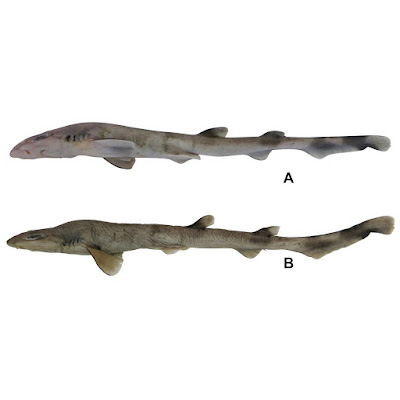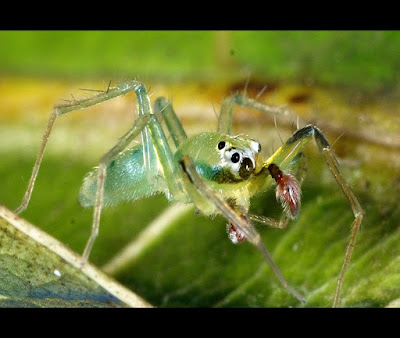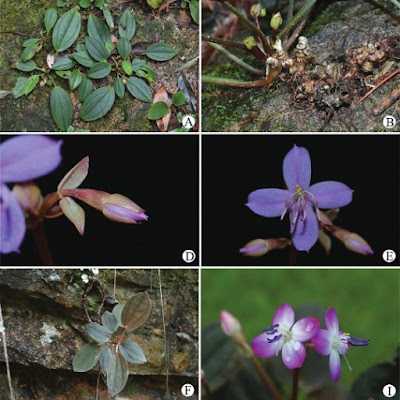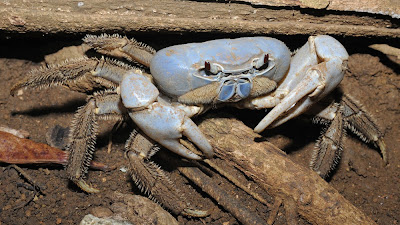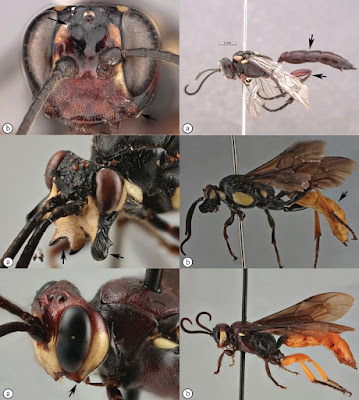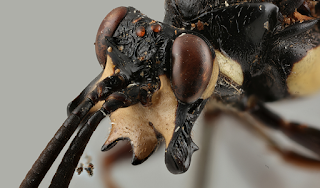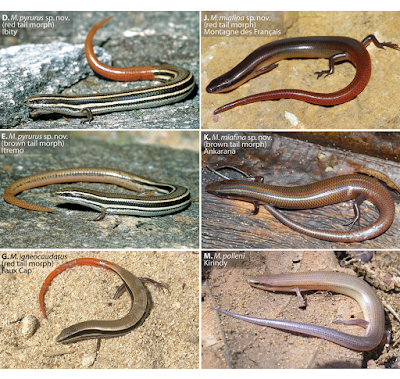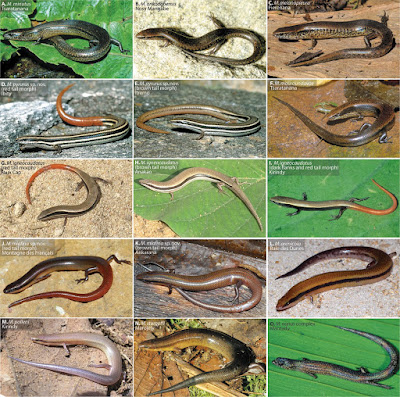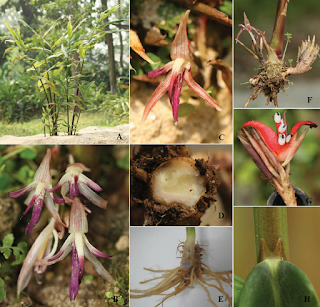[Most Recent Entries] [Calendar View]
Saturday, December 10th, 2016
| Time | Event | ||||
| 2:37a | [Ichthyology • 2016] Galeus corriganae • A New Species of Deepwater Catshark (Carcharhiniformes: Pentanchidae) from Papua New Guinea
Abstract A new species of catshark, provisionally placed in the genus Galeus, is described from Papua New Guinea based on 7 specimens collected during recent deepwater surveys of the region. The new species, Galeus corriganae, is closest to G. priapus from New Caledonia and G. gracilis from northwestern Australia but differs in several morphological characters. A reclassification of the catshark groups is required to revise the familial and generic arrangement of the group. Keywords: Pisces, Galeus, catshark, new species, Papua New Guinea, Pentanchidae  William T. White, Ralph R. Mana and Gavin J. P. Naylor. 2016. Galeus corriganae sp. nov., A New Species of Deepwater Catshark (Carcharhiniformes: Pentanchidae) from Papua New Guinea. Zootaxa. 4205(3); 255–264. DOI: 10.11646/zootaxa.4205.3.5 Introducing Corrigan's Catshark - Galeus corriganae - a new catshark from Papua New Guinea named after Dr Shannon Corrigan @CTOL_Project twitter.com/WillWhitesharks/status/806291117901651968  | ||||
| 3:04a | [Arachnida • 2016] Description of Three New Species of the Tropical Asian Jumping Spider Genus Onomastus Simon, 1900 (Araneae: Salticidae) from High Altitude Cloud Forests of Sri Lanka
Abstract Spiders of the tropical Asian jumping spider genus Onomastus Simon, 1900 are small to medium-sized, delicate, translucent, commonly found inhabitants of Asian evergreen forest foliage. In this paper, three new species of the genus, Onomastus jamestaylori sp. nov. (♂♀), Onomastus corbetensis sp. nov. (♂♀) and Onomastus maskeliya sp. nov. (♂♀) are described from Sri Lanka. The three new species are added to the matrix of a previous study to assess their phylogenetic position. The resulting cladistic analysis, based on 35 morphological characters from 18 taxa (13 Onomastus species and 5 outgroups) supports the monophyly of the genus. Additionally, a monophyletic, well-supported South Asian clade (India, Sri Lanka), which is restricted to the Sri Lanka-Western Ghats biodiversity hotspot, is recovered in most analysis. The three newly described species might be endangered due to their small population size and restricted distribution in high altitude cloud forest. Keywords: Araneae, Phylogeny, endemics, synapomorphies, monophyly, parsimony, India, mountaintops
Benjamin, Suresh P. and Nilani Kanesharatnam. 2016. Description of Three New Species of the Tropical Asian Jumping Spider Genus Onomastus Simon, 1900 from High Altitude Cloud Forests of Sri Lanka (Araneae: Salticidae). Zootaxa. 4205(5); 431–453. DOI: 10.11646/zootaxa.4205.5.2 | ||||
| 3:10a | [Botany • 2016] Fordiophyton zhuangiae • A New Species (Melastomataceae) from Guangdong, China based on Morphological and Molecular Evidence Abstract Historically, the taxonomic study of the Asian genus Fordiophyton has had some gaps. Several specimens from Guangdong (China) have been misidentified as Fordiophyton brevicaule C. Chen. The new species proposed here shares with F. brevicaule the densely hirsute stem, rosetted leaves and glabrous hypanthia, but it is distinguished by its glabrous leaves, winged petioles, oblong petals lacking a single trichome at the apex, and purplish anthers in the longer set of stamens. The phylogenetic analyses indicate that it is a member of Fordiophyton and sister to F. brevicaule. Based on morphological and molecular data, we here recognize it as a new species, Fordiophyton zhuangiae S. Jin Zeng & G. D. Tang, which is described and illustrated. Zeng Sijin, Ge-Han Huang, Qiang Liu, Xiao-Kai Yan, Guo-Qiang Zhang and Guang-da Tang. 2016. Fordiophyton zhuangiae (Melastomataceae), A New Species from China based on Morphological and Molecular Evidence. Phytotaxa. 282(4); 259–266. DOI: 10.11646/phytotaxa.282.4.2 | ||||
| 4:00a | [Crustacea • 2012] Discoplax celeste • The Blue Crab of Christmas Island (Decapoda: Brachyura: Gecarcinidae)
Abstract The indigenous Blue Crab of Christmas Island, previously misidentified as “Discoplax hirtipes (Dana, 1851)”, is here recognised as a distinct new species, Discoplax celeste. In addition to its unique blue-coloured carapace when adult, the new species can be distinguished from true D. hirtipes by carapace, male abdominal, and male first gonopod characters. To stabilise the taxonomy of Cardisoma hirtipes Dana, 1851, a neotype from the original type locality in Fiji, is selected. A separate eastern Indian Ocean taxon, Discoplax aff. hirtipes, present in the Andaman Islands, Nicobar Islands and western Sumatra is also found in small numbers on Christmas Island. KEY WORDS: Crustacea, Brachyura, Discoplax, new species, Christmas Island Etymology. — The name is derived from the French céleste meaning sky or heaven and alludes to the sky or powder blue live colour of adults of this species. The name is used as a noun in apposition. Peter K. L. Ng & Peter J. F. Davie. 2012. The Blue Crab of Christmas Island, Discoplax celeste, New Species (Crustacea: Decapoda: Brachyura: Gecarcinidae). Raffles. Bull. Zool. 60(1); 89–100. https://lkcnhm.nus.edu.sg/nus/pdf/PUBLIC | ||||
| 11:42a | [Entomology • 2016] Genaemirum phagocossorum, G. phacochoerus & G. fumosum • Review of the Genus Genaemirum Heinrich (Hymenoptera, Ichneumonidae) with Interactive Identification Keys to Species Abstract We describe Genaemirum phagocossorum Rousse, Broad & van Noort, sp. n., a new ichneumonine parasitoid wasp reared from Eucalyptus nitens logs infested by the cossid moth Coryphodema tristis, which is considered a major pest of forestry and food crops in South Africa. This is the first plausible host association for the genus, and fits with the host association predictions of Heinrich. Two further undescribed species were found in the collections of the Natural History Museum in London and are described as Genaemirum phacochoerus Broad, Rousse & van Noort, sp. n. and Genaemirum fumosum Broad, Rousse & van Noort, sp. n. An identification key to the eight known species and a diagnosis for each species are provided, including photographs of all the primary type specimens. Online Lucid interactive identification keys are available at: http://www.waspweb.org. Keywords: Africa, Afrotropical region, biocontrol, Ichneumonidae, Ichneumoninae, host, identification key, parasitoid wasp, species description, systematics
Genaemirum phagocossorum Rousse, Broad & van Noort, sp. n. Etymology: From the latin “cossus” for “worm or grub found in wood”, which is the likely host (Cossidae), and “phago” = latin for “a glutton”. Noun in the genitive case. Genaemirum phacochoerus Broad, Rousse & van Noort, sp. n. Etymology: The name is derived from the genus name for warthogs, after the resemblance of the head to that of a warthog. Noun in apposition. Genaemirum fumosum Broad, Rousse & van Noort, sp. n. Etymology: The name is derived from the Latin for "smoky", in reference to the infuscate wings. Noun in apposition. Pascal Rousse, Gavin R. Broad and Simon van Noort. 2016. Review of the Genus Genaemirum Heinrich (Hymenoptera, Ichneumonidae, Ichneumoninae) with Interactive Identification Keys to Species. ZooKeys. 636: 77-105. DOI: 10.3897/zookeys.636.10216 'Monstrous' wasps could reveal their species' secrets Scientists have identified three new species of parasitoid wasp - including two that previously lay undescribed in the Museum's collections. | ||||
| 1:08p | [Herpetology • 2016] Species Delimitation Methods Put Into Taxonomic Practice: Two New Madascincus Species, M. miafina & M. pyrurus, formerly allocated to Historical Species Names (Squamata, Scincidae) Abstract In a previous study, Miralles and Vences (2013) compared seven different methods of species delimitation applied to the genus Madascincus. While focusing on methodological aspects their study involved an extensive data set of multilocus DNA sequences and of comparative morphology. On this basis they emphasized the need of revising the taxonomy of Madascincus, and revealed the existence of at least two well-supported candidate species. The present paper provides formal descriptions of these two taxa: (1) Madascincus miafina sp. n., a species from dry areas of northern Madagascar, morphologically very similar to M. polleni (although both species are not retrieved as sister taxa), and (2) Madascincus pyrurus sp. n., a montane species occurring >1500 m above sea level, endemic to the central highlands of Madagascar (Ibity and Itremo Massifs). Phylogenetically, M. pyrurus is the sister species of M. igneocaudatus, a taxon restricted to the dry littoral regions of the south and south-west of Madagascar in lowlands <500 m above sea level. To facilitate future taxonomic work, we furthermore elaborated an identification key for species of Madascincus. Finally, some aspects of the biogeographic patterns characterising the different main clades within the genus Madascincus are provided and discussed for the first time in the light of a robust phylogenetic framework. Key Words: Madascincus miafina sp. n., Madascincus pyrurus sp. n., Madagascar, phylogeny, morphology, integrative taxonomy, species complex, biogeography
 Aurélien Miralles, Jörn Köhler, Frank Glaw and Miguel Vences. 2016. Species Delimitation Methods Put Into Taxonomic Practice: Two New Madascincus Species formerly allocated to Historical Species Names (Squamata, Scincidae). Zoosystematics and Evolution. 92(2); 257-275. DOI: 10.3897/zse.92.9945 | ||||
| 1:33p | [Botany • 2010] Elettariopsis wandokthong • Elettariopsis Baker (Zingiberaceae) in Thailand-A New Species and A New Record
ABSTRACT Six taxa of Elettariopsis Baker (Zingiberaceae) were previously accounted for Thailand. In this paper, Elettariopsis wandokthong, a new species from Thailand, is described and illustrated. Also, the distribution of E. monophylla (Gagnep.) Loes. in Thailand is reported here for the first time with full description and illustration. Key to species currently enumerated for Thailand is also provided. KEY WORDS: Zingiberaceae, Thailand, Elettariopsis wandokthong, new species, Elettariopsis monophylla, new record.  Diagnose: Elettariopsidi trilobae similis, foliis 2-4 lanceolatis ad oblongis vel ellipticis utrinque glabris, ligula 1-2 mm longa pubescenti, apice bilobo, calycis tubo corollae tubo longiore pubescenti, ovario pubescenti differt. Distribution: This new species can only be found in the type location. However, it is widely cultivated in Thailand. Ecology: The new species grows under the shade of dried deciduous forest, at the altitude of 62-240 m. Vernacular names: Wan Dokthong (วานดอกทอง), Wan Maha Saneh (วานมหาเสนห), 彎斗松擬荳蔻 (Chinese new name). Ethnobotany: This new taxon is believed to process a magical power, and therefore, it is used as a good-luck charm. The Thai names imply magical seductive power. The plants are grew in pots, and put in front of shops believing that they will help attracting customers, especially when the plant is in bloom (usually as early as January to early May). The rhizomes of this taxon are also used as one of the ingredients for making “magical herbal charming oil” or “magical charming lip balm”, believing that after applying it to one’s body (oil) or lips (lip balm), it will help attracting the targeted opposite sex, particularly women. Chayan Picheansoonthon and Piyapong Yupparach. 2010. Further Study on the Elettariopsis Baker (Zingiberaceae) in Thailand-A New Species and A New Record. Taiwania. 55(4); 335-341. Orawan Theanphong, Thatree Phadungcharoen, Thaya Jenjittikul and Withawat Mingvanish. 2016. Essential Oil Composition of Elettariopsis wandokthong Picheans. & Yupparach Rhizome from Thailand. BHST [Bulletin of Health Science and Technology] . 14(1); 30-35. | ||||
| 3:45p | [Botany • 2015] Zingiber hainanense • A New Species (Zingiberaceae) from Hainan, China
ABSTRACT Zingiber hainanense (Zingiberaceae), a new species from Hainan, China, is described and illustrated. It is compared to two most similar members from Z. sect. Cryptanthium, Z. guangxiense from Guangxi, China and Z. kawagoii, an endemic species from Taiwan, China. Zingiber hainanense differs from Z. guangxiense mainly by labellum and staminodes being purple red (vs. yellowish white throughout in Z. guangxiense), and differs from Z. kawagoii by labellum and lateral staminodes being linear or narrowly ovate (vs. obovate-oblong in Z. kawagoii). The pollen morphology and chromosome number count as well as a color plate of the new species are also presented in this study. Keywords: Angiospermae; Liliopsida; Zingiberidae; Zingiberales; Zingiberaceae, Monocots, China Yu-Shi Ye, Lin Bai and Nianhe Xia. 2015 Zingiber hainanense (Zingiberaceae), A New Species from Hainan, China. PHYTOTAXA. 217(1):73. DOI: 10.11646/phytotaxa.217.1.6 |
| << Previous Day |
2016/12/10 [Calendar] |
Next Day >> |
